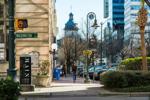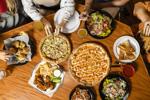COLUMBIA — When the COVID-19 pandemic hit in March 2020, the phones at restaurants like Richland Street’s Spotted Salamander Café and Catering and Cayce’s Duke’s Pad Thai started ringing with customers wanting to order take-out.
“I would be like, ‘just take the phone off the hook,’” Spotted Salamander’s chef-owner Jessica Shillato said, of the overwhelming nature when the virus first began. “‘We’re not doing to-go orders right now.’”
More than three years later, the phone lines are still ringing at some Columbia restaurants, joining a national trend of restaurants leaning more on takeout ordering than ever before. Shillato now attributes more than half of sales at her cafes — a Richland Street location and a recently opened Main Street location — to takeout ordering.
Shillato considers takeout to be such a “huge part” of the industry following the last three years. She’s not alone.
The restaurant industry nationally is getting a radical makeover as takeout is the new trend. Nearly one fifth of sales in American restaurants last year could be attributed to takeout ordering, according to the Wall Street Journal.
In some Columbia restaurants, this has meant changes to kitchens and business models to accommodate the new customer preference. For others, it meant a way to continue business throughout the pandemic.
Noi Souvanna, the owner of Duke’s Pad Thai and the upcoming Little Bee Bun Mee, said during the height of the pandemic, her restaurant didn’t lose money. Instead, she saw an influx of takeout orders.
“We’re always breaking records and takeout is always a very strong part of our business,” Souvanna told Free Times.
The restaurant updated aspects of the kitchen to accommodate for the number, Souvanna said.
“As a company, we’re always changing ways to service the guests,” Souvanna said. “Get as many people in and out as fast as possible.”
However, Souvanna said she can’t compare the influx of takeout orders before the pandemic because of her restaurant’s growth over the last three years. Duke’s Pad Thai had many people online ordering and ordering takeout in the restaurant before the pandemic, but the volume of orders they get now cannot be compared, she said.

Spotted Salamander, whose owner Shillato was recently named a semifinalist in this year’s James Beard Foundation awards, has been noticeably busier than before, but Shillato said the restaurant hasn’t changed kitchen operations as a result.
While the takeout boom has helped some Columbia restaurants, it also often means having to bring on additional employees, Shillato said. Her restaurant halted its curbside pickup option because “you have to employ a whole person to do that,” Shillato said.
Leaning heavily on takeout, and less on dine-in service, could mean restaurants have to rely on less staff, restaurant owners like Souvanna said. She doesn’t plan on converting to takeout only, since she does have the staff to handle both.
While more casual, lunch places like Spotted Salamander and Duke’s have seen an influx of orders, other spots say they haven’t noticed much of an increase.
Palmer Ray, former general manager of The War Mouth, said the restaurant offered takeout only during 2020. Ray remembers ordering better takeout boxes in larger quantities than before COVID-19 hit.
The laidback Southern-food Cottontown restaurant toyed with streamlined third party delivery outlets, like Grub Hub or Door Dash, but ultimately decided against it because management found the outlets unreliable.
Ray said the restaurant has about six to eight takeout orders a week.

“It’s not a huge change,” Ray said.
Keith Johnson, general manager of Jake’s Bar and Grill, said the Five Points bar popular with college students and dog-lovers alike, operates the same as it did before March 2020.
Jake’s closed for seven weeks when the pandemic began but reopened in May 2020. Since opening back up, take-out orders have been low on average.
“If you want something to go, we’ll make it for you, but we don’t do a lot of walk-in to-go orders very often,” Johnson said.
Plus, Jake’s kitchen and operation isn’t set up for the takeout business, which affected the bar’s decision on whether to lean on it following the pandemic.
“During the COVID period, (takeout) was definitely discussed,” Johnson said. “But the kitchen is toward the back of (the building). If everything was closed, you’d have to have a cashier or someone out front.”
